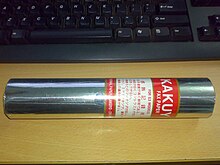Thermal paper


Thermal paper is a special fine paper that is coated with a chemical that changes color when exposed to heat. It is used in thermal printers and particularly in inexpensive or lightweight devices such as adding machines, cash registers, and credit card terminals.
The surface of the paper is coated with a solid-state mixture of a dye and a suitable matrix; a combination of a fluoran leuco dye and octadecylphosphonic acid as an example. When the matrix is heated above its melting point, the dye reacts with the acid, shifts to its colored form, and the changed form is then conserved in a metastable state when the matrix solidifies back quickly enough.
Usually, the coating will turn black when heated, but coatings that turn blue or red are sometimes used. While an open heat source, such as a flame, can discolor the paper, a fingernail swiped quickly across the paper will also generate enough heat from friction to produce a mark.
Most direct thermal papers require a protective top-coating to:
- reduce fading of the thermal image caused by exposure to UV light, water, oils, grease, lard, fats, plasticizers, and similar causes
- provide improved print head wear
- reduce or eliminate residue from the thermal coating on the thermal print heads
- provide better anchorage of flexographic printing inks applied to the thermal paper
- focus the heat from the thermal print head on the active coating.
History
The earliest direct thermal papers were developed by NCR Corporation (using dye chemistry) and 3M (using metallic salts). The NCR technology became the market leader over time, although the image would fade rather rapidly compared with the much more expensive, but durable 3M technology.
Texas Instruments invented the thermal print head in 1965, and the Silent 700, a computer terminal with a thermal printer, was released in the market in 1969. The Silent 700 was the first thermal print system that printed on thermal paper. During the 1970s, Hewlett-Packard integrated thermal paper printers into the design of its HP9800 series desktop computers, and integrated it into the top of the 2600-series CRT terminals as well as in plotters.
In the 1970s and early 1980s, Japanese producers (such as Ricoh, Jujo, and Kanzaki), using similar dye-based chemistry, formed partnerships with barcode printer manufacturers (such as TEC, Sato, and others) and entered the emerging global bar code industry, primarily in supermarkets. U.S. producers such as Appleton (NCR's licensee), Nashua Corporation, Graphic Controls, and others fought to gain market share. Leading pressure-sensitive label producers such as Avery Dennison became major consumers of direct thermal paper for label applications.
In the late 1980s and early 1990s, thermal transfer, laser printing, electrophotography, and, to a lesser extent, ink jet printing began to take away industrial and warehouse barcode applications due to better durability. Direct thermal made a strong comeback with point of sale receipts (gasoline pumps, cash registers, rental car receipts, etc.).
During 1998, Nintendo used thermal paper technology for their Game Boy Printer.
In 2006, NCR Corporation's Systemedia division introduced two-sided thermal printing technology, called "2ST"
Health and environmental concerns
Some thermal papers are coated with BPA, a chemical considered to be an endocrine disruptor. This material can contaminate recycled paper.[1][2] BPA can transfer readily to the skin in small amounts:
When taking hold of a receipt consisting of thermal printing paper for five seconds, roughly 1 μg BPA (0.2–0.6 μg) was transferred to the forefinger and the middle finger if the skin was rather dry, and about ten times more than this if these fingers were wet or very greasy. Exposure to a person who repeatedly touches thermal printer paper for about ten hours per day, such as at a cash register, could reach 71 micrograms per day, which is 42 times less than the present tolerable daily intake (TDI).[3]
The chemical bisphenol A (BPA) is used for thermal paper coatings because of its stability and heat-resistance. This allows inkless printing for receipts from cash registers. People who often get in contact with BPA coated receipts do have a higher level of BPA in their bodies than people with average contact. Therefore, the New York Suffolk County signed a resolution to ban BPA in thermal receipt papers. Violation of this new law, the “Safer Sales Slip Act”, involves a 500 USD penalty. One year after having been filed in the Office of the State Secretary, the new law will come into force.[4]
See also
References
- ^ Attention: This template ({{cite doi}}) is deprecated. To cite the publication identified by doi:10.1016/S0045-6535(00)00507-5, please use {{cite journal}} (if it was published in a bona fide academic journal, otherwise {{cite report}} with
|doi=10.1016/S0045-6535(00)00507-5instead. - ^ Gehring, Martin (2004). "Bisphenol A Contamination of Wastepaper, Cellulose and Recycled Paper Products" (PDF). Waste Management and the Environment II. WIT Transactions on Ecology and the Environment, vol. 78. WIT Press. Retrieved 2009-10-15.
{{cite web}}: Unknown parameter|coauthors=ignored (|author=suggested) (help) - ^ Biedermann, Sandra; Tschudin, Patrik; Grob, Koni. "Transfer of bisphenol A from thermal printer paper to the skin". Analytical and Bioanalytical Chemsitry. 398 (1): 571–576. doi:10.1007/s00216-010-3936-9. PMID 20623271. Retrieved May 11, 2011.
- ^ New York Suffolk County Bans BPA in Thermal Receipt Papers SafeGuardsBulltin No. 006/13, Retrieved 2013-05-31
